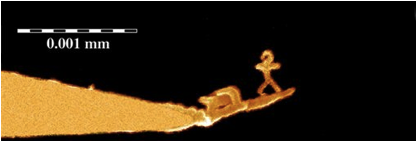Who invented nanotechnology?

In less than a month, the ROBOT BALL will begin , and so much more needs to be written! Here, for example, nanotechnology - many connect the future of robotics with them, but very few even imagine the history of “nano”.
In the courtyard of 2014, we came close to miniature machines consisting of individual atoms. Nano-tubes have already appeared and the creation of graphene is sensational. The US Congress promises by 2030 the onset of the singularity and the release of anthropomorphic robots based on nanomaterials.
At the same time, there is not even a definition of the term “nanotechnology”, and the history of the term itself is complex and confusing - that’s how we deal with it.

It is believed that nano-technology originates in a report by Richard Feyman“There is a lot of space at the bottom,” then Feynman surprised the audience with general discussions about what would happen if the miniaturization of electronics that had begun had reached its logical limit, the “bottom”.
But this is the only way it is considered, in reality, nanotechnology originates only in 1989, at the same time Feyman got into scientific circulation and report, but first things first.
During the second half of the 20th century, both miniaturization technologies (in microelectronics) and means of observing atoms developed. The main milestones of microelectronics are as follows:
- 1947 - invention of a transistor;
- 1958 - the appearance of the chip;
- 1960 - photolithography technology, industrial production of microcircuits;
- 1971 - the first Intel microprocessor (2250 transistors on one substrate);
- 1960-2008 - the effect of the "Moore's Law" - the number of components per unit area of the substrate doubled every 2 years.
Further miniaturization rested within the limits set by quantum mechanics. As for microscopes, the interest in them is understandable. Although the x-ray images helped to “see” a lot of interesting things - for example, the double helix of DNA - I wanted to see the micro objects better. Here the chronology is as follows:
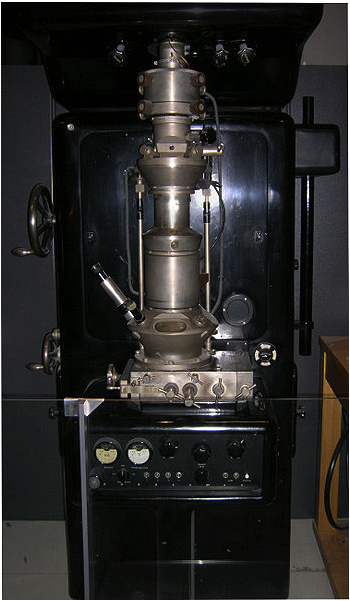
- 1932 - E. Ruska invented a transmission electron microscope. According to the principle of operation, it is similar to a conventional optical one, only electrons instead of photons, and a magnetic coil instead of lenses. The microscope gave an increase of 14 times.
- 1936 - E. Muller proposed the construction of an autoelectronic microscope with an increase of more than a million times. In principle, it looks like a shadow theater: images of micro-objects located on the tip of a needle emitting electrons are displayed on the screen. However, needle defects and chemical reactions made it impossible to obtain an image.
- 1939 - Transmission electron microscope Ruski began to increase 30 thousand times.
- 1951 - Müller invented the auto-ion microscope and obtained an image of atoms on the tip of a needle.
- 1955 - The world's first image of a single atom, obtained by an autoion microscope.
- 1957 - The world's first image of a single molecule, obtained by field electron microscope.
- 1970 - Image of a single atom obtained by transmission electron microscope.
- 1979 - Binnig and Rohrer (Zurich, IBM) invented a scanning tunneling microscope with a resolution no worse than the above.
It became possible to observe objects not only in a vacuum, but in gases and liquids (hello, microbiology!); plus, the microscope gave a truly three-dimensional picture of the surface topography.

But this is not the main thing. In the world of elementary particles, quantum mechanics operate, which means that observation cannot be separated from interaction. Simply put, it turned out very quickly that with a microscope it is possible to cling and move molecules, or change their electrical resistance with a simple pressure.
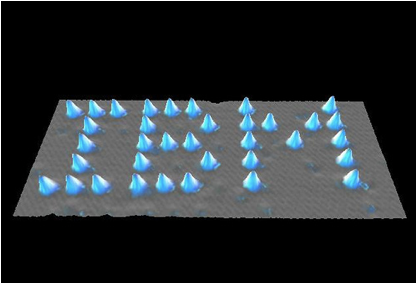
At the end of 1989, the scientific world spread over a sensation: a person learned to manipulate individual atoms. An employee of IBM Donald Eigler, who worked in California, wrote on the metal surface the name of his company with 35 xenon atoms. This picture, subsequently circulated by the world media and already settled on the pages of school textbooks, marked the birth of nanotechnology.
The repetition of success immediately (in 1991) was reported by Japanese scientists who created the inscription “PEACE” 91 HCRL ”(World in 1991, HITACHI Central Research Laboratory). True, they did this inscription for a whole year and not at all by the method of placing atoms on the surface, but on the contrary - they were picking out unnecessary atoms from a gold substrate.
It was only in 1996 that Eigler was able to actually achieve the achievement - at the IBM Zurich laboratory. As of 1995, there were only five laboratories in the world involved in the manipulation of atoms. Three in the USA, one in Japan and one in Europe. At the same time, the European and Japanese laboratories belonged to IBM, that is, they were also in fact American.
What was left for European politicians and bureaucrats to do in such a situation? Just shout about the harmful effects of progress for the environment and the dangers of new technologies in American hands.
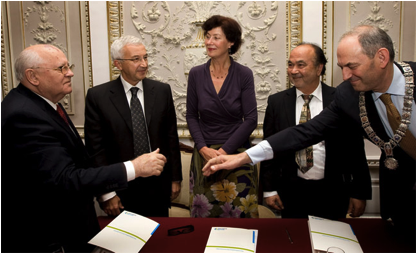
Back in the 1970s, the famous " Roman Club"”Put forward the ideology of“ sustainable development ”. The report “The Limits of Growth” explicitly stated that the old Europeans couldn’t take chase after America, which means that the idea of “preserving what was achieved” should be propagated - well, the environment should be protected there and quotas should be introduced for industrial development under the guise of protecting the atmosphere.
Eric Drexler is certainly the “son of a regiment” of the Club of Rome and a leading promoter of European values in the states. A popularizer of science, a politician and “like an engineer”, from his youth imbued with the ideas of “limits of growth”.

In 1986, he published the book "Machines of Creation" and created the "Institute of Foresight." The book describes nanorobots that can create their own kind, as well as the situation when they get out of control: the “gray slime” of ecofage nanorobots leads the planet to an environmental disaster. The “nano-slime” meme was quite popular in the media of the early nineties. Drexler himself is often called almost the father of nanotechnology.
Which is not fair and wrong, because nanotechnology is the achievement of IBM laboratories. But it so happened that it was Drexler who launched the topic in popular culture, and loud sensations in the nanoworld occurred exactly at the time of the frenzied popularity of his book “Creation Machines”.
So the role of Drexler was key in this story. In the summer of 1992, Senator Albert Gore invited him to address the Senate on the topic "New Technologies for Sustainable Development." A year before the speech, he defended his dissertation at the Moscow Institute of Economics “Molecular Machines: Production and Use in Computers” and, being an excellent speaker, managed to convince senators of the reality and practical use of manipulating molecules. So the lobbyist group was born in the US Senate and "nanotechnology" moved into the field of politics. The next year, Gore becomes US Vice President.

It is worth remembering that this is about the beginning of the nineties - the Cold War ended and the US government was confused scratched the back of its head in search of the direction of billions freed from the war. Ecology, environmental protection, nanotechnology and "sustainable development" sounded excellent and could well win this tender. there was only one problem.
American industrialists and scientists did not want anything “stagnant”, they wanted to capture world markets, build new accelerators and increase profits with Nobel prizes. Al Gore, being vice president of the United States (1993-2001), never mentioned “sustainable development,” even in his report “The Development of Science in the National Interests” (1994) nanotechnologies were mentioned only in passing. Although after retirement, already as a private person, Gore returned to nanotechnology and the ideas of the Roman club, for which he received the Nobel Peace Prize for combating global warming (2007).
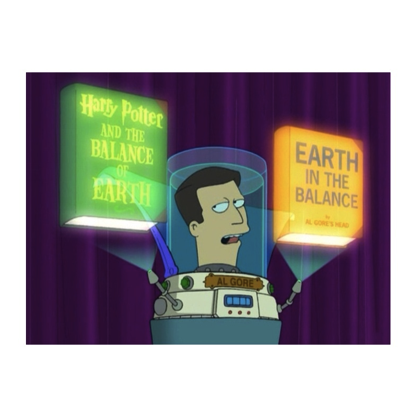
All this shook the scientific position of the writer Drexler. Prior to that, claims were made against him in a “weak scientific base”, and the “Institute of Foresight” no, no, they called it a charlatan sect - and then the vice president supported the idea only partially. According to Gore's report, nanotechnology was supposed to be used not for environmental purposes, but for the development of American industry!
This is where the magic begins.
On the one hand, the National Science Foundation, scientists and industrialists considered Drexler and its nanotechnology a quackery, but on the other hand, a flywheel of discussion of the initiative was already launched at the very top and it was planned to allocate significant amounts for research.
In this case, it was in the second half of the nineties and everyone saw how efficiently Gore was able to develop another innovative project - the Internet.

1996, Clinton and Gore lay the LAN at school
Few people know, but it was thanks to the efforts of Gore that the creation of the Internet infrastructure and even the first browser, mosaic, were fully funded . But most importantly, the administration of Horus has created the conditions for investing in the Internet. What brought explosive growth of the industry in 1999 and superprofits for participants called “dot-com booms”. It all ended with the collapse of the “dotcom bubble” just a year later, but the job was done. Despite the collapse of the market, Horus is deservedly called the "father of the Internet", without it everything would have appeared ten years later - and Google, and even a hubr.
The question inevitably arose - but would nanotechnology promise the same quick profits as the Internet? Worth a try.
In 1999, the National Nanotechnology Initiative project finally fell on the president’s table. The project was so well worked out and combed that some problem arose. If the environment was thrown out, sustainable development was forgotten, and mechanosynthesis was dissolved in hundreds of other technologies, then why specifically spend billions of dollars on all this? What exactly will give NNI to America? No explanation was given.

NNI started in 2000 with a speech by Clinton in front of students of Caltech. Its public funding amounted to $ 300 million, and increased over the following years, regardless of the political situation (1.8 billion in 2011, approximately 10% of NASA's budget).
Clinton spoke in an audience where Feynman back in 1959 made his famous talk. Speech was introduced into scientific circulation by Drexler in 1989, using it to its fullest. Therefore, nanotechnological tradition undeservedly ascribes the first impetus to Feynman.
But the “nanotechnology" itself began to cause more and more questions. 14 years have passed since the start of the initiative, tens of billions have been allocated, and where is the result? It can be assumed that it is classified. Or ... just not doing what we expect.
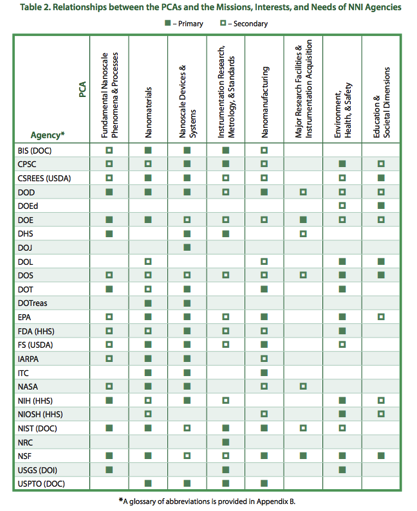
If we suppose that NNI has a hidden core, such as a program for creating anthropomorphic robots, then combining such diverse directions within the framework of one program looks quite logical. As well as the association for this, 25 departments and agencies, including the key NSF, DOE, DOD, NIH, NASA and NIST. So the lack of funding problems for 14 years.
You can also recall that Boston Dynamics, which impressed the audience with its robotic models, left MIT exactly in 1992 - right after Drexler defended his dissertation there, which consisted of general words, promises and forecasts ... On the other hand, the reviews openly talk about possible the use of nanotechnology in the production of a wide variety of robots for the needs of the Ministry of Defense - from nanomachines to a mechanical person indistinguishable from the present.
In general, NNI made a strong impression on Europe. But in order to somehow control, develop or prohibit "nanotechnology" - it was necessary to give them a definition.
Unlike NNI, in the European program “Nanotechnology, Materials and Processes”, it was clearly said about “sustainable development” and about the possibility of the future transformation of “nanotechnology” into “ecotechnology”. In 2004, the total funding of "nano" in the EU amounted to 1 billion euros (in England - 45 million f.st.).
And only in 2011 did the European Commission finally approve the official concept of “nanomaterials”: in them the proportion of particles with sizes of 1-100 nanometers (in at least one dimension!) Is from 1 to 50 percent. It is especially noted that fullerenes, graphene flakes and carbon nanotubes also belong to nanomaterials.
Anything falls under such a definition. It makes even a housewife a nanotechnologist who has dripped oil onto the surface of the water. That is, under the brand of nanotechnology, anything can be hidden.
